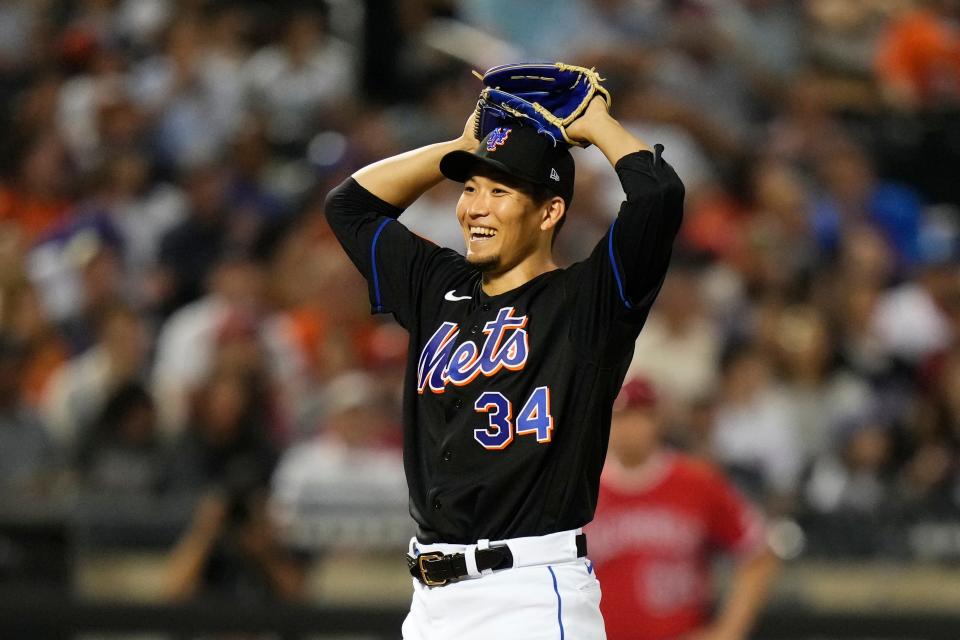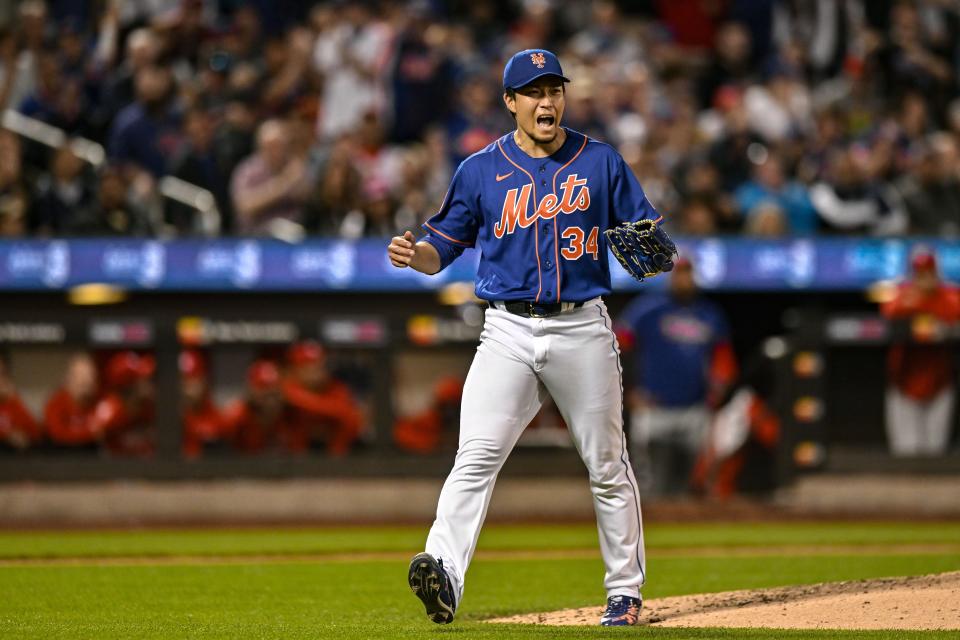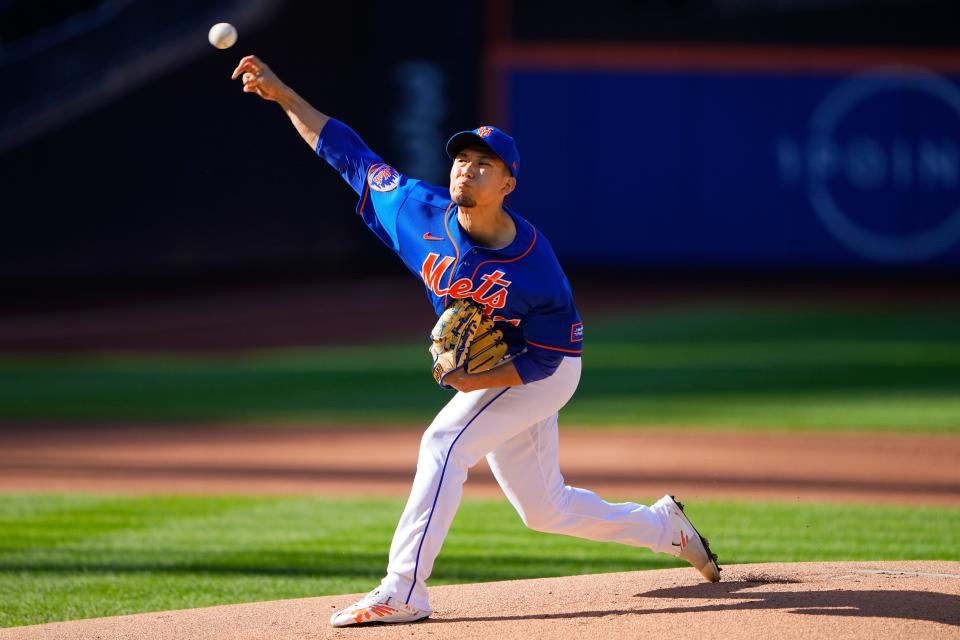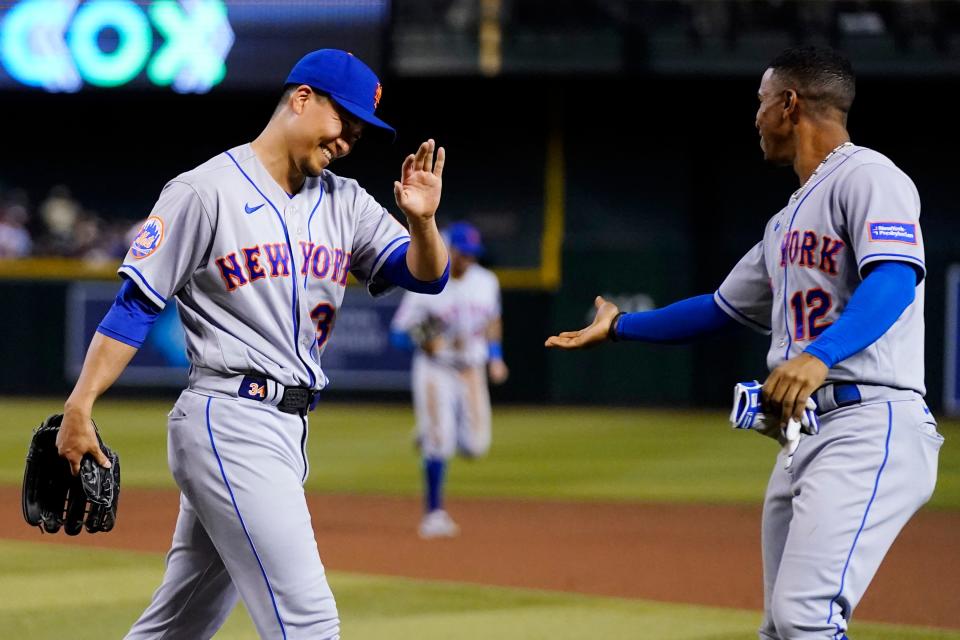Seeing ghosts: How Mets players and coaches view Kodai Senga's ace potential
NEW YORK — As the Mets approached the offseason after the 2022 campaign, there was a degree of mysticism surrounding Kodai Senga.
The Japanese sensation, who was set to turn 30 years old in January, had a supernatural pitch in his ghost forkball and played a key role in helping the Fukuoka Softbank Hawks win six Japan Series in Nippon Professional Baseball in his 10 seasons with the team, including four straight between 2017 and 2020.
But how would that translate overseas? After signing a five-year, $75 million deal with the Mets after Jacob deGrom's departure to the Rangers, there were initial questions about how Senga would adapt to Major League Baseball.
In the midst of the turmoil of the Mets' 2023 season, including the trades of both Max Scherzer and Justin Verlander, Senga has proved to be a harbinger of optimism beyond this season. In less than one season, Senga has gone from a relative unknown to a legitimate well-regarded mercenary.

"I was so happy that we got him because I thought he was going to be such a complement to Max and Justin going into the season and then having (Jose Quintana) there too," Mets pitching coach Jeremy Hefner said. "Obviously it didn’t all shake out like we originally planned, but in and of himself, respectively, he could be an ace for these next four years. Having that weapon on our side and not having to face him is definitely exciting."
Entering his final start of the 2023 season, Senga has been the team's most dependable starter, posting a 12-7 record while making 28 starts and throwing 161⅓ innings. He has struck out 194 batters, notched a 2.96 ERA — second-best in the National League — and 1.22 WHIP, and the ghost forkball has become one of the most diabolical pitches in all of baseball.
"Quick learner and someone that doesn’t give up," Francisco Lindor said. "There’s a reason why he’s here and he got paid a lot of money to come here. We got a good one on our side, for sure. He’s happy, works. He has his routine. He doesn’t change it, he sticks to it. He’s consistent, and consistency is the key to be successful in the big league."
What sets Kodai Senga apart

For Senga, everything from his opening statement at his introductory press conference to his routine between starts is carefully mapped out and regimented.
When Senga stepped on the bullpen mound for the first time adjacent to Clover Park last March, the discussions began between Senga, Hefner and Mets interpreter Hiro Fujiwara. What are the data points he wants to know during mound visits? What doesn't he like to hear?
Veterans, like Adam Ottavino, appreciated Senga's attention to detail and baseball acumen, which helped quell the language barrier.
"He's very well versed in every aspect of his job, whether it's his sleep, his nutrition, his training, his mechanics, what pitches to throw," Ottavino said. "I can tell that he watches a ton of baseball and is obsessed with the game like some of us are and that's going to serve him really well, that ability to have that adaptable mindset and have aptitude and figure things out, because every year things are changing."
Related: How Mets' Kodai Senga is building his case for Cy Young Award
As Senga adjusted to the new variables, including a less tacky baseball, a more grueling travel schedule and different mound, one of the qualities that has stood out to both Hefner and Ottavino was Senga's abililty to read hitters in the moment.
Along with athleticism, that ability to adjust on the fly serves as a foundation for some of the best pitchers in the game, including Scherzer and Verlander.
"They’re all really good athletes other than baseball," Hefner said. "They have a really good understanding of how to play the game and to understand that confrontation between him and the batter and the feedback that the batter’s giving him on the pitches and also how their pitches are performing that day.
"Knowing when to push on a pitch and when to scale back on a pitch, Kodai has a pretty good feel for that. The sky’s the limit."
'The magic pitch'

Ottavino uses Baseball Savant as a weapon to analyze what is working with his own arsenal, but Senga's forkball "breaks the system." It's the first time the Mets reliever has seen a pitch with no spin metrics associated with it.
The highly-variable, plunging pitch induces a swing and miss 59.7 percent of the time — the best whiff percentage among any pitch deployed by starting pitchers this season.
"I know how he does it, but I can't do it," Ottavino said. "The way he gets the ball to spin, with the arm speed he has, clearly the hitters are completely fooled. Most of the time they’re swinging, and we've seen some of the worst misses on that pitch of any I've ever seen in the big leagues. It's a great pitch."
And one that continues to baffle opponents. It will be his calling card until they prove they can hit it.
With a forkball that can be volatile, Hefner credited Senga's body awareness and repeatable mechanics for his ability to dial it in regularity. Senga throws the forkball 23.9 percent of the time, with opponents batting .100 against it.
Rotation: How Joey Lucchesi is making his case for Mets' starting rotation in 2024 and beyond
"I’ll be honest, you don’t necessarily know where the ball is going," Francisco Alvarez said through interpreter Alan Suriel. "Sometimes it cuts, sometimes it goes in, sometimes it sweeps and you always have to be on your toes. You really just have to be ready to block it at any given point.
"But when he’s on with that forkball, he can throw it for strikes, he can throw it for a ball, it’s one of those special pitches that makes it hard to hit for any hitter."
Chiseling his arsenal

It would be a disservice to base Senga's efficiency during his rookie season completely around his signature pitch. The newcomer's productivity moving forward is likely to come with the remainder of his arsenal.
With a vicious strikeout pitch, strong velocity and good feel, Senga is far from a one-trick pony.
His four-seam fastball checks in at an average of 95.6 mph. The cutter was relatively new for Senga before the season and he worked with Driveline to throw a harder version than he had in Japan. The result is a pitch that he can spot in the strike zone in the low-90s. The cutter is Senga's best run value pitch this season.
"It was the sweeper and the cutter were the two pitches that he kind of added to help his in-zone rate," Hefner said. "Then the sweeper didn’t perform like we wanted it to, so we leaned more on the cutter and that’s proven to be successful."
Senga's sweeper, which has 45.1 inches of vertical drop, was largely nixed early in the season. He drops in a curveball every once in a while to keep hitters off-balance. The fastball, cutter and forkball have been his bread and butter.
"I think it helps tremendously to have those different pitches because of the different movement and the different velocities that he can throw them at," Alvarez said. "I think he can take advantage of hitters’ weaknesses in those counts because he has that variety of pitches to be able to get them to."
There is still room to tinker and grow for Senga, which could make the Mets starter that much more treacherous to go up against.
"It's so important (to have multiple pitches) because you can't get to two strikes, you can’t throw (the forkball) and also to keep your pitch count at a reasonable number you’ve got to get some contact outs as a starter especially," Ottavino said. "That's kind of the trick is, 'How do I get people out but be efficient and go deep in the game?' and he's gotten better and better at that."
This article originally appeared on NorthJersey.com: Kodai Senga: How NY Mets players, coaches see Cy Young potential

